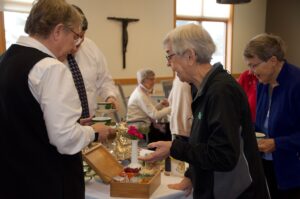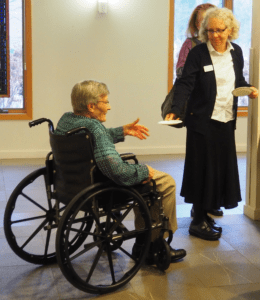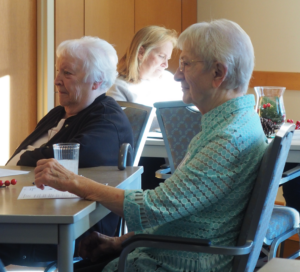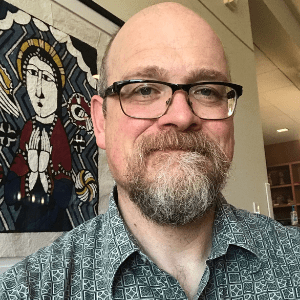The Rule mentions a lot about how mealtimes and table rhythms should work for the Community, but here’s the deal—food and fellowship are experienced directly, and words fall a little short.
When the pandemic started at the Monastery, a lot of stuff got disrupted, including meal patterns. When I started, I was half-time, and I wasn’t staying for lunch. Then, after a while, the Benedictine Center reopened, and I began a pattern of eating in the Riepp Room (that big conference room at the Monastery). Eventually, after a long while, everyone began eating in the main dining room again.
I stuck to going to lunch at roughly noon, because … well … my timesheet was easier to add up that way. Not much of a reason, I suppose. A few months ago, one of the Sisters asked that employees might eat with the Sisters at midday—show up at about 11:45 so we could all eat together. No one really said exactly why, but the general drift was that the room was a little empty.

Sisters Linda Soler, Mary Lou Dummer, and Paula Hagen with Sister Virginia Matter in the background during the 2023 St. Blaise Tea
So, now I try to make it to lunch at 11:45 as often as I can, because it’s kind of cool to be able to help things out a little just by showing up to lunch. I get to notice things, too. At the risk of saying something out of turn, sometimes I see Sisters who I know are getting on each other’s nerves sitting at the same table, eating together. And I consider it—every time.
And more and more these days, I think that the Sisters are showing me the heart of community—a bond that has become family. They really have become sisters, just like my brother and I are still brothers even when we annoy each other. Family doesn’t stop being family because of tension and friction, at least families that are functioning don’t stop the relationships because of difficulties.
And community should be similar—or at least it should aspire to being something like family. The idea of community as family even shows up in Scripture a lot, as we all know from exhortations to treat each other as brothers and sisters in Christ. There are other ways that Scripture presents community as well, some of which are less familiar. For instance, Parker Palmer uses the Last Supper as both a scriptural image of community and an example of it:
[T]he story of Christ gathering people into community reaches one of its high points in the Last Supper. Perhaps I should have said “low points.” Here is Jesus who has been pouring out his life for the people seated around the table. Now he has brought them together in the universal rite of friendship, family, and hospitality – breaking bread together and passing the cup. And what do these people do? First, in response to Jesus’ claim that one of them will betray him, they deny that any such thing is possible: “Not us, Lord, not here, not in this nice church!” Having taken care of that little matter they move right along to an argument about who is the greatest among them! Blind to their own capacity for betrayal, and obsessed with power struggles, the disciples at the table act out two of the issues that make community life so painfully difficult ….And what does Jesus do in the midst of all of this? Being fully human, he must have been tempted to get up and leave – just as you and I are when our romantic images of community fail. But Jesus does not leave. Instead, he keeps breaking the bread and passing the cup. Both here and in the rest of his story Jesus demonstrates his commitment to staying at the table.
If we are to follow Jesus Christ, we must try to stay at the table with our own communities, in our own churches and elsewhere.
Even though I like what Palmer is saying there, it’s tough to know exactly how to live up to an example like that. I mean really, how do we emulate Christ’s self-giving leading up to the Crucifixion? It seems huge—but perhaps it’s also incredibly mundane. At the risk of sounding trite, putting up with people really is a form of self-giving, and it can take decades for people to realize how difficult they can be sometimes (and some people never seem to get there). I’ve been on both sides of the process—I’ve been both a pain to others as well as someone bearing with others—and it’s ragged and slow in both lanes.
Really slow, painfully slow, sometimes mind-numbingly slow—both because of the difficult people and also because of the people enduring them. We all know about the problem people (I’m sure a couple have already jumped to mind for you), but let’s not forget to talk about the people enduring difficult others, too.
Encountering difficulties in others is a challenge to all of us to examine our foundational convictions—a challenge to examine whether or not we really believe Christ is present in everyone. It’s easy to perceive Christ in others when the relationships are like a big party where everything is breezy and easy and beautiful. It's slower going to learn to recognize and honor Christ in other people who aren’t as convenient, especially when Christ is disguised in fragile egos and eccentric quirks and all the rest of the embarrassing stuff that makes up each of us.
Each of us—each and every one of us—but not all of us have to face up to it. Like I said earlier, I’ve been in both lanes on the plays-well-with-others highway of life, and I have to admit I like being the magnanimous condescending person better. I like being able to think about whether or not I should continue to “invest” in relationships with people who irk me (and most of the other people in the room). I like being able to conveniently avoid hassles with others and think well of my improving social chops, all the while protecting my time and energy.
And the example of Christ at the Last Supper flies in the face of all of that. Christ chose to be present to the profoundly imperfect people who were with him. He stayed at the table with them, knowing that it would soon cost him dearly.
If I am to follow Christ and participate in community, I must do the same—regardless of the fragile egos and eccentric quirks and all the embarrassing stuff—whether from others … or from me. I must be committed to taking my seat at the table and staying there, both metaphorically and literally.
And that sounds big and heavy and complicated and abstract—but sometimes it’s as simple as just showing up to lunch.



